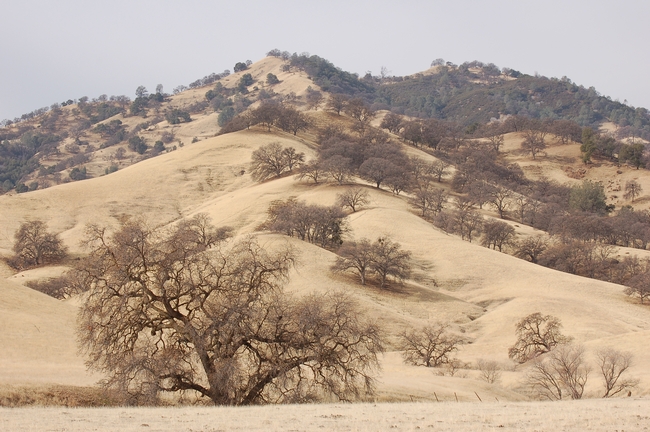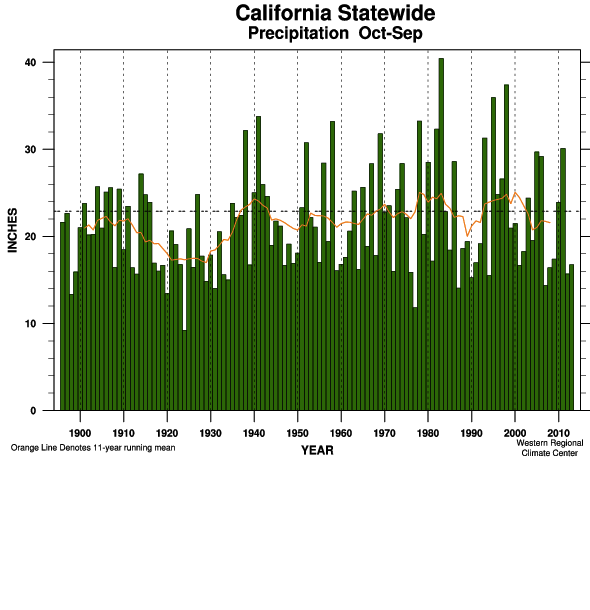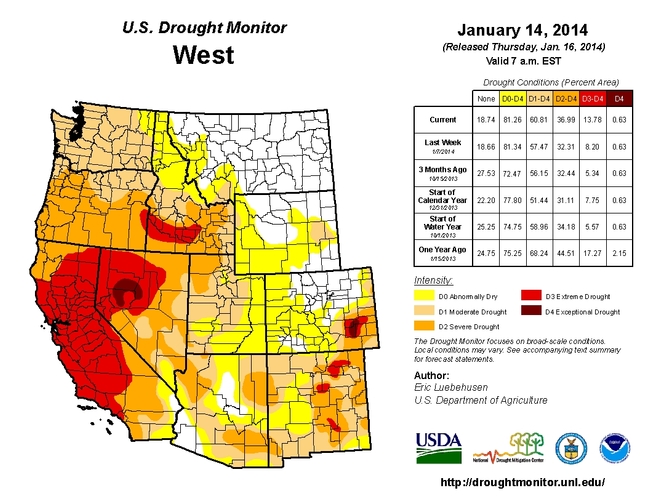If trends continue as per current predictions, the continued drought in California will have serious impacts to forage production in 2014, affecting the availability and price of animal feed.
It’s like an 800-pound gorilla in the room, worrying everyone including growers, suppliers, livestock operators and consumers alike. According to the Western Regional Climate Center, October-December of 2013 was the driest on record in California. Other western states are also experiencing drought to varying degrees (note the U.S. Drought monitor map for the west below). Current predictions are for zero to slight chances of rainfall for the rest of January for most of California.
Figure 1. Millions of acres of foothill and coastal grasslands are normally lush green, dotted with grazing cattle in January, but this year are dead brown – this causes havoc for livestock producers and increases demand for hay. (Photo by Phil Hogan, NRCS, 2014)
This drought is likely to have impacts in several areas:
Annual Small Grain and Miscellaneous Hay. On the supply side, oat hay, which is typically grown as a dry land crop in most of California, is a disaster. Roughly 200,000 acres of oats are planted each year in our state (it was 180,000 in 2013), and it’s unlikely that these will yield much, except for the relatively small percentage of irrigated acres. Many fall plantings never even germinated, leaving fields appearing as if they were fallowed. Those plants that germinated from the scant amount of rainfall we did receive are withering. In addition to oats, the yield and acreage of other small grain forages and meadow hay forages will likely be far less this year. Summer annuals such as sudangrass may be out of the question for some areas due to the water scarcity for irrigation, and irrigated pasture production may also be curtailed. The lack of inexpensive oat and other coarser hays has a large impact on beef producers, who are seeking sources of feed for hungry animals that have little range to feed on this winter.
Figure 2. Rainfed oat field in Yolo County, CA showing crop failure. Normally, growth would be knee high by now. Hundreds of thousands of acres of forage production may be lost due to lack of winter rainfall in 2013-14.
Alfalfa. Seedling alfalfa fields planted in the fall should now be a carpet of green. Instead, a number of fields never established, a casualty of north winds and dry conditions that shriveled seedlings. The extreme cold in December did not help either, and these new stands are behind – and existing stands were frozen back. Many thousands of dollars spent for seed and field preparation have been lost.
Alfalfa is a perennial crop that remains in production for four to five years and needs water to be productive. Essentially none of the state’s alfalfa fields have had ‘winter re-charge’ from rainfall which carries the crop into spring until irrigation is initiated. With a shortage of water, difficult choices will have to be made on which crops to irrigate.
In the Central Valley, it is expected that growers will shift water resources from alfalfa to trees and vines, which represent high investments to protect, or to tomatoes or other contracted annuals that have attractive prices this year.
For alfalfa, there are options for deficit irrigation, which means choosing when to stop watering (usually mid-summer). However, the plants will go into a drought-induced dormancy, resulting in significant yield losses, though the stands almost always recover when irrigated again. All of these factors point to a diminished alfalfa supply situation in 2014.
Demand. On the demand side, the utter lack of rain has resulted in nearly zero growth of rangeland forage, causing livestock producers and horse owners to purchase hay that would normally not be needed over the fall and winter period. The coastal and Sierra foothills, normally green and dotted with animals, are dry and sparsely stocked or not stocked at all due to a lack of drinking water for livestock. In rangelands that are stocked, the only available forage consists of any carryover of dry forage from last year, which is of very poor quality. Many livestock producers are using corn stover, rice straw and feed supplements to get them through this period when they usually have “free” feed on rangeland. Thus, demand for hay from grazed animal producers has increased tremendously due to the drought, which has been reflected in an upturn in prices for the medium to lower grade hay.
In addition, the dairy price situation has improved, which should improve demand for hay, and exports are again scheduled to increase in 2014. Currently, about 11% of alfalfa produced in the western states is exported to foreign markets.
Price. Corn grain prices have gone down in recent months, which tends to have a depressing influence on hay prices. Additionally, alfalfa acreage has gone up slightly, which also tends to suppress prices, but it should be noted that locally and nationally, these are not historically high acreages for alfalfa, and miscellaneous hay acreage is quite a bit down. The slightly higher acreage may be more than offset by reduced productivity. The improved dairy situation and anticipated increases in export demand, as well as demand from beef operators and horse owners should continue to create demand for forage crops. With the drought conditions likely to continue, feed will remain in short supply and prices pushed higher than would be expected under normal conditions.
Some Historical Perspective. California has experienced numerous droughts in the past, as shown on statewide yearly precipitation graph below. However, this drought is unprecedented in that it has been so dry since January of 2013, making it tough, if not impossible to establish winter forages. Many growers rely on rainfall for crop emergence and then on water from irrigation districts for subsequent irrigations. However, with our reservoirs at a fraction of capacity (around 20% in many cases), many districts are facing zero water allocations at this time, or severe cutbacks. Many growers are putting in new wells, but this means more pressure on our limited groundwater resources.
For now, let’s all hope for rain to try to get the gorilla out of the room. However, we should probably start planning for what appears to be a drought of momentous proportion that we will likely be talking about for years.



